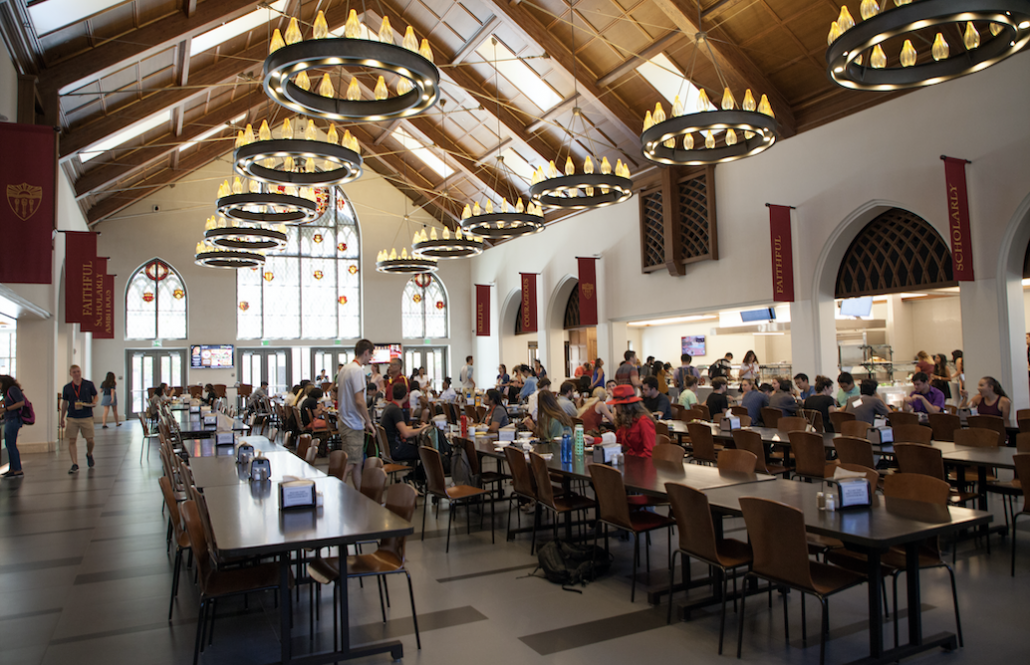Getting in — then getting fed

When Courtney Moore transferred to USC in Spring 2016, she knew that her family’s low socioeconomic status meant they would be unable to assist with living costs. So Moore, who has since graduated, made sure to apply for benefits from the Supplemental Nutrition Assistance Program — otherwise known as food stamps — to supplement her grocery budget.
But a year after she matriculated at USC and had moved into Cardinal Gardens for the 2017-18 school year, she was told she was required to purchase USC’s mandatory apartment meal plan, adding $1,260 to her yearly expenses.
“When I found out I had to pay for [the apartment meal plan], I was shocked. I mean, I had to reevaluate my expenditures,” Moore said.
Food insecurity affects thousands of students like Moore at USC, where in 2017, 21 percent of undergraduate students were eligible for Pell Grants — a form of federal aid granted to low-income students. Over 2,000 students visited the Trojan Food Pantry in Parkside Apartments last semester to pick up free groceries.
For many, restrictions and requirements like the apartment meal plan create an additional burden that hinders access to adequate amounts of healthy, affordable food. Students cite the high costs of food on and around campus, the expensive mandatory meal plans and poor University communication as issues that exacerbate food insecurity and consequently increase personal stress.
One of those students is Laura Pearson, a sophomore majoring in philosophy and cognitive science, who receives SNAP benefits and recently ran for a Undergraduate Student Government senator position with food insecurity as a platform point.
“With a lot of students here being fairly well-off, I think a lot of them don’t realize just how much of a struggle other students have that are not as financially secure,” Pearson said. “I also think that goes hand-in-hand with the administration.”
‘You do not have the chance to say no’
The apartment meal plan, which costs $1,300 for the 2018-19 school year, includes 150 dining dollars and 40 meal swipes per semester. That’s enough to cover roughly 110 meals, leaving more than 560 meals for students to cover on their own dimes throughout the year.
Students eligible for CalFresh, California’s extension of SNAP, receive anywhere from $100 to $200 a month to help pay for food — about the same price as the meal plan. But unlike the apartment meal plan, students say they can make CalFresh benefits last by using them at several stores, including Trader Joe’s and Target, to cover all of their groceries for the month.
“If someone has the ability to get funding from another entity, why should they be forced to use the dining dollars [and] the dining plan?” Pearson said.
The apartment meal plan was created to give students convenience, in addition to ensuring students have access to food, according to Associate Director of Residential Dining Erik Russell. But requests to opt out are evaluated on a case-by-case basis, and students who are on SNAP cannot opt out.
“This is a situation in which a meal plan [has] price points that are wrong; you can argue the amount is awkward, and they’re pushing it onto people,” USG Sen. Gabriel Savage said. “You do not have the chance to say no. It’s frustrating.”
As a result, students like Moore have had to take out extra loans to cover the additional expenses the apartment meal plan poses.
Moore fought the requirement after discovering the charge in her student account, teaming up with Mai Mizuno, then-USG director of community and external affairs, but ran into several dead ends. Eventually, Moore received an email from Lindsey Pine, a registered dietician working with USC Hospitality that read: “Financial issues and number of meals per day do not play a role in meal plan exemptions.”
Later, Pine told her to consider off-campus living options.
“I felt like they believed that I had a choice, financially, to live off campus,” Moore said. “It didn’t seem as if they were understanding, or even trying to understand, and I felt like I was automatically denied the waiver regardless of my financial situation.”

Village for some, food desert for others
For low-income students living in or near USC Village, expensive food choices can create additional financial issues.
At SunLife Organics, a bowl or smoothie costs between $7 and $10, and the most expensive shake costs nearly $28.
At BBCM, the most popular entrees range from $16 to $30. Only one of its soup and salad options falls below $10. For pasta, the cheapest option is $19. Similarly at both Greenleaf and Saola, no sandwiches or burgers are cheaper than $10.
“I think that USC does a good job of recruiting low income students, but I think once they get in the doors … there are so many barriers,” said Alec Vandenberg, USG director of external affairs. “I think that USC Village is a prime example of that. It’s very catered to a certain population on campus that can afford it, and it’s very exclusionary.”
Many students are unhappy with how expensive the average meal at USC Village is. They are also unable to use meal swipes there.
“I tend to try not to eat on campus or at [USC Village] because of the prices,” Pearson said.
Sarah Portnoy, a USC faculty member who specializes in food deserts and food insecurity, said that “of course” low-income students might gravitate more toward unhealthy options like local fast food chains because of the cost of the food offered at USC Village.
“The area around USC is classified as a food desert,” Portnoy said.
Developing resources
Portnoy said that to combat some of these problems, she would suggest offering more affordable vendors or establishing a program with different price points depending on income status.
A few on-campus resources already exist to assist students who experience food insecurity. Toward the end of the 2017-18 school year, the Trojan Food Pantry transitioned from a virtual pantry to occupying a physical space on campus and in Fall 2018, it transferred from a room in the Student Union to a slightly larger location at the base of Parkside Apartments.
The pantry offers support for students trying to sign up for CalFresh, as well as food that food-insecure students can choose from weekly. However, the pantry previously did not allow students on the apartment meal plan to pick out food.
Now, the pantry has moved to allow its services to be “only available to any currently enrolled USC student who does not have a dining hall meal plan or whose plan’s swipes have been fully used,” according to its website.
Between Sept. 7 and Dec. 19, over 2,200 people visited the food pantry, with roughly 60 to 70 attendees every day, according to Student Programs Advisor Luis Canton.
Another resource for students is the Late Night Hot Meal program, which is held at the United University Church on campus on Wednesdays. The program serves about 80 to 120 people every week and was established in Spring 2016.
Russell said USC encourages students to look outside the University for local resources, and to speak to financial aid or an EBT case worker. Russell also said more solutions may become available in the future, but that he’s not ready to give details at this time.
“There’s a lot of movement, and a lot of ideas on the table, and I think that you’re going to see this being more [of] a topic, and you’ll see more solutions as we move forward,” Russell said.

